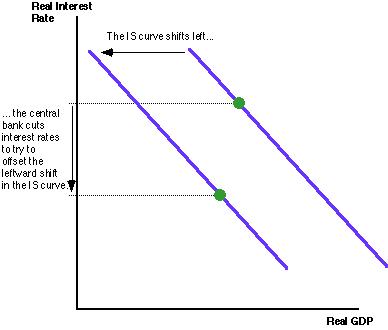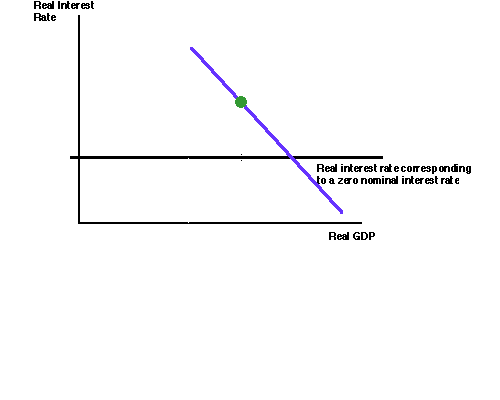| The terror attack on the World Trade Center on September
11, 2001 caused a fall in consumer confidence: consumers have cut back
on their spending on durables. It also caused a fall in businesses’ willingness
to invest: many businesses are cutting back on investment and other spending
as they wait to learn more about what the future will be. |
| How large are these shifts? Nobody knows. Everybody agrees
that these consequences of the terror attack have shifted the IS curve
back to the left. Nobody knows by how far—nobody knows what the position
of the IS curve next summer will be. However, any policy changes that the
government wants to put in place to affect the state of the economy in
late 2002 need to be put into place now, or they will not have time to
have an impact on the state of the economy until 2003. |

|
|
The Shock Shifts the IS Curve Back to the Left
|
| Thus from the central bank’s perspective, its task is
(a) to assess how large the leftward shift in the IS curve is; (b) to reduce
interest rates so as to move the economy down and to the right along the
IS curve and so offset the shift in the IS curve, keeping the economy near
full employment; and (c) to perform this reduction in interest rates now,
before there is enough information to assess the magnitude of the shift
in the IS curve.To say the least, this is a difficult task. |
|
Why a Stimulus Package Might Be Desireable
|
| In response, the Federal Reserve has reduced interest
rates by a full percentage point in an attempt to stimulate investment
spending and offset the contractionary impact of the shock. But can the
Federal Reserve do enough? Its ability to reduce interest rates is limited
by the fact that the nominal short-term interest rates it controls—and
that now stand at 2.5% per year—cannot go below zero. Moreover, the effect
of interest rate reductions may be limited: to the extent that investment
spending is limited not by the cost of finance but by the fact that businesses
value keeping the option to delay decisions about the future until the
uncertainty generated by the terror attack is resolved, the Federal Reserve’s
tools may be weak. |

|
| If it does turn out to be the case that the fall in spending
produced by the terror attack is large, and that the Federal Reserve’s
tools to fight the resulting recession are weak, then there will be a strong
argument for stimulative policies—like expanded government spending—that
affect the position of the IS curve directly, and would shift it to the
right. |
| Unfortunately, the decision about a stimulus package
must be made now, before we understand the magnitude and persistence of
the shock to consumer confidence and business willingness to invest. |

